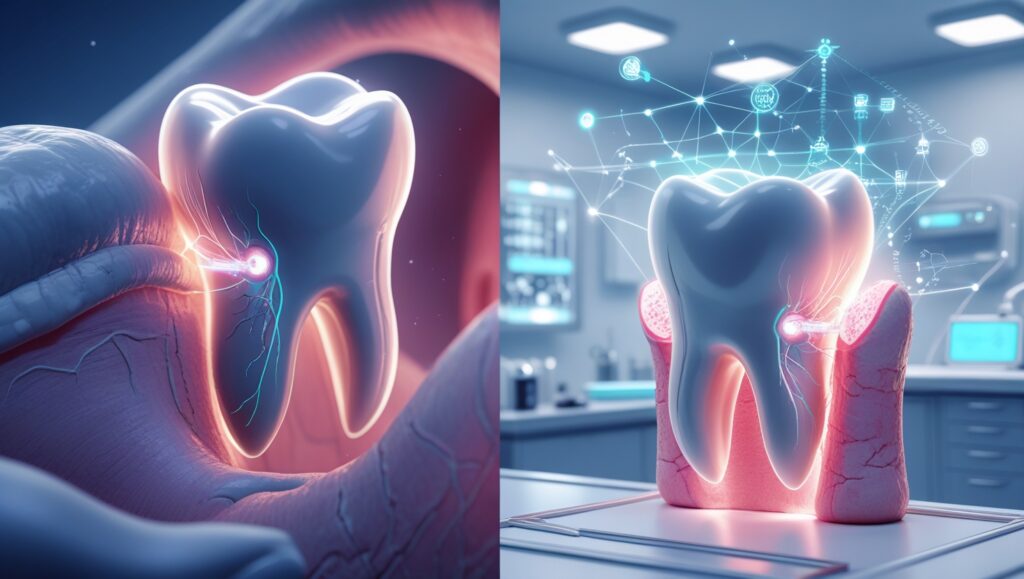The Rise of the “Smart Tooth”: A Bioengineered Leap in Dentistry

For decades, dentistry has relied on titanium implants as the gold standard for replacing lost teeth. Strong, durable, and able to fuse with the jawbone, these implants have restored countless smiles. Yet one thing has always been missing: the sensory feedback of a natural tooth. Unlike the real thing, titanium implants cannot feel pressure, temperature, or texture. They restore form, but not function.
Now, a new generation of research is attempting to change that. Scientists have recently developed a bioengineered “smart tooth” implant that promises to behave more like the real thing—integrating not only with the gums but also with nerves. While still in its earliest stages, tested only in rodents so far, this innovation marks a remarkable step toward dental implants that can truly replicate the experience of natural teeth.
How the Smart Tooth Works
At the heart of this invention is a deceptively simple idea: rather than anchoring a lifeless prosthetic into the jawbone, why not coax the body to grow around and into the implant, restoring living connections?
The device itself is coated with a biodegradable layer loaded with stem cells and growth proteins. As the implant is placed, this layer encourages the surrounding tissue to regenerate, particularly by forming new nerve connections. Over time, as the coating dissolves, the implant becomes embedded not just in bone but in living gum tissue, linked directly to the body’s sensory network.
A second innovation lies in how the implant fits into the mouth. Traditional titanium implants require bone drilling, a process that is invasive and often traumatic for the surrounding tissues. By contrast, the smart implant uses a memory-foam nanofiber layer that gently expands to fill the socket. This approach minimizes trauma and creates a hospitable environment for new nerves to grow and connect.
Restoring the Mouth–Brain Connection
The promise of this technology lies in its ability to restore signals between the mouth and the brain. In rodent studies, imaging revealed that the implant was not merely stabilizing—it was integrating through soft tissue while reconnecting with nerves. The result was something unprecedented in dental research: an artificial tooth capable of restoring sensory abilities.
Imagine biting into an apple and feeling its crisp resistance, sipping tea and sensing its heat, or distinguishing textures while chewing—all functions that titanium implants cannot reproduce. The smart implant seeks to bridge this sensory gap, giving patients not only a tooth that looks real, but one that feels real.
Where the Research Stands
So far, the results are promising. After six weeks in rodent trials, the implants have been shown to be stable, biocompatible, and capable of nerve integration. The rodents tolerated the devices without signs of rejection, and researchers confirmed that soft tissue and neural pathways were reconnecting as hoped.
Still, the road to human application is long. Scientists emphasize that the project remains in the preclinical stage. More extensive animal studies must come first, both to refine the design and to rule out long-term complications. Only after these steps can the technology progress to clinical trials in people.
The Future of Dentistry
While patients should not expect to see smart tooth implants in their dentist’s office anytime soon, the implications are profound. For the first time, researchers are moving beyond replacement to regeneration—harnessing the body’s own biology to restore lost function.
If successful in humans, this technology could transform the field of restorative dentistry. Tooth loss would no longer mean settling for a static replacement. Instead, patients could receive implants that feel alive, re-establishing the intricate sensory feedback that nature designed.
The vision is still experimental, but the direction is clear. Dentistry is moving toward a future where artificial teeth are not simply substitutes for the real thing, but living, sensing extensions of the body itself. And with every breakthrough in bioengineering, the line between repair and regeneration grows thinner.